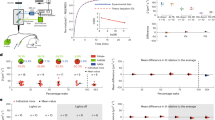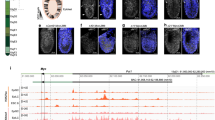Abstract
Several studies suggest direct roles for androgens and oestrogens in the development of sexually dimorphic characteristics of mouse and rat brain1. To elucidate the biochemical mechanisms for such effects, investigators have asked which putative steroid receptors are present in the hypothalamus throughout the critical period of sexual differentiation. A priori, potential receptors would include high-affinity proteins with selectivities for active androgens, oestrogens and their metabolites. Two major classes of steroid that might be active as agonists are the androgens per se, including testosterone and dihydrotestosterone (DHT)2, and the oestrogens, which are themselves androgen metabolites3. Normally, in sexual differentiation, a proper balance of both androgens and oestrogens may be necessary4. Indeed, receptors for each of these ligands do exist in the hypothalamus of neonatal and prepubertal mice4–7. Although the perinatal oestrogen receptor and its function have been extensively studied7,8, the existence of perinatal androgen receptors has not been as clearly demonstrated to permit a similar acceptance9. In this report, we establish the existence of adult-like androgen receptors in embryonic and neonatal mouse and rat hypothalami by qualitative biochemical and genetic analyses. This is achieved by DNA–cellulose affinity chromatography and velocity sedimentation, and by analysis of the androgen-resistant mutant, testicular feminisation. The presence of sex hormone receptors in perinatal brain is discussed in the context of behavioural responses which are differentiated during the critical period of brain sexual development.
This is a preview of subscription content, access via your institution
Access options
Subscribe to this journal
Receive 51 print issues and online access
$199.00 per year
only $3.90 per issue
Buy this article
- Purchase on Springer Link
- Instant access to full article PDF
Prices may be subject to local taxes which are calculated during checkout
Similar content being viewed by others
References
Barraclough, C. A. in Advances in Reproductive Physiology (ed. McLaren, A.) (Logos, London, 1968).
Farnsworth, W. E. & Brown, J. R. J. Am. med. Ass. 183, 140–143 (1963).
Heard, R. D. H., Jellinck, P. H. & O'Donnell, V. J. Endocrinology 57, 200–204 (1955).
Fox, T. O. Proc. natn. Acad. Sci. U.S.A. 72, 4303–4307 (1975).
Fox, T. O. Nature 258, 441–444 (1975).
Attardi, B. & Ohno, S. Endocrinology 99, 1279–1290 (1976).
Fox, T. O., Vito, C. C. & Wieland, S. J. Am. Zool. 18, 525–537 (1978).
Vito, C. C. & Fox, T. O. Science 204, 517–519 (1979).
Plapinger, L. & McEwen, B. S. in Biological Determinants of Sexual Behavior (ed. Hutchinson, J. B.) (Wiley, New York, 1978).
Wieland, S. J., Fox, T. O. & Savakis, C. Brain Res. 140, 159–164 (1978).
Fox, T. O. Brain Res. 128, 263–273 (1977).
Attardi, B., Geller, L. N. & Ohno, S. Endocrinology 98, 864–874 (1976).
Attardi, B. & Ohno, S., Cell, 2, 205–212 (1974).
Bullock, L. P. & Bardin, C. W. Endocrinology 94, 746–756 (1974).
Gehring, U. & Tomkins, G. M. Cell 3, 59–64 (1974).
Verhoeven, G. & Wilson, J. D. Endocrinology 99, 79–92 (1976).
Kato, J. Ann. Biol. Anim. Biochem. Biophys. 16, 467–469 (1976).
Stanley, A. J., Gumbreck, L. G., Allison, J.E. & Easley, R. B. Recent Prog. Horm. Res. 29, 43–64 (1973).
Hart, B. L. Horm. Behav. 8, 193–200 (1977).
Goldfoot, D. A. & Van Der Werff Ten Bosch, J. J. Horm. Behav. 6, 139–148 (1975).
Goy, R. W. in Recent Advances in Primatology Vol. 1 (eds Chivers, D. J. & Herbert, J.)(Academic, New York, 1978).
Gandelman, R., vom Saal, F. S. & Reinisch, J. M. Nature 266, 722–724 (1977).
Vom Saal, F. S. & Bronson, F. H. Biol. Reprod. 19, 842–853 (1978).
Clemens, L. G., Gladue, B. A. & Coniglio, L. P. Horm. Behav. 10, 40–53 (1978).
Vreeburg, J. T. M., van der Vaart, P. D. M. & van der Schoot, P. J. Endocr. 74, 375–382 (1977).
Davis, P. G., Chaptal, C. V. & McEwen, B. S. Horm. Behav. 12, 12–19 (1979).
Booth, J. E. J. Endocr. 79, 69–76 (1978).
Harris, G. W. Endocrinology 75, 627–648 (1964).
Gerall, A. A., McMurray, M. M. & Farrell, A. J. Endocr. 67, 439–445 (1975).
Gladue, B. A. & Clemens, L. G. Endocrinology 103, 1702–1709 (1978).
Clemens, L. G. & Gladue, B. A. Horm. Behav. 11, 190–201 (1978).
Author information
Authors and Affiliations
Rights and permissions
About this article
Cite this article
Vito, C., Wieland, S. & Fox, T. Androgen receptors exist throughout the ‘critical period’ of brain sexual differentiation. Nature 282, 308–310 (1979). https://doi.org/10.1038/282308a0
Received:
Accepted:
Issue Date:
DOI: https://doi.org/10.1038/282308a0
This article is cited by
-
Effect of an inhibitor of aromatization, 1,4,6 androstatriene-3,17-dione (ATD) on LH release and steroid binding in hypothalamus of adult female rats
Experimental Brain Research (1986)
-
Sexual differentiation of the brain
Nature (1981)
Comments
By submitting a comment you agree to abide by our Terms and Community Guidelines. If you find something abusive or that does not comply with our terms or guidelines please flag it as inappropriate.



